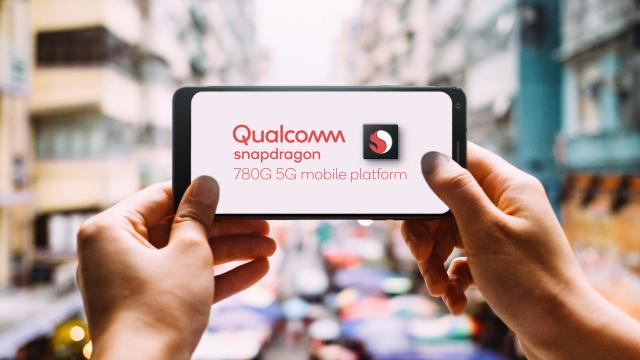Qualcomm’s Snapdragon 888 chip is clearly the company’s flagship CPU, powering everything from Samsung’s Galaxy S21 line to a bunch of gaming phones and whole lot more. Now Qualcomm is announcing the new Snapdragon 780G chip, which promises to bring flagship performance to mid-range handsets.
The Snapdragon 780G is the successor to last year’s 765G and 768G chips, which were featured in phones like the Pixel 5, and is a fresh update to Qualcomm’s mid-range mobile processor line.
The 780G is based on a Kryo 670 CPU that Qualcomm claims is 40% faster than the 768G, with an Adreno 642 GPU capable of supporting screens with up to 144Hz refresh rates. The 780G is also based on a 5nm architecture, which is a first among Qualcomm’s mid-range 7-series chips, and should translate into better power efficiency across the board.
[referenced id=”1677194″ url=”https://gizmodo.com.au/2021/03/qualcomms-looking-to-fix-wireless-audio-with-snapdragon-sound/” thumb=”https://gizmodo.com.au/wp-content/uploads/2021/03/05/h2w5mdiyt4rqumaudi9f-300×163.png” title=”Qualcomm’s Looking to Fix Wireless Audio with Snapdragon Sound” excerpt=”As the industry continues to transition to wireless audio, Qualcomm has a plan to make the audio quality on Bluetooth headphones sound a little more like the sound you hear on wired ones.”]
The 780G also features Qualcomm’s 6th-gen AI engine powered by a Hexagon 770 processor with a fused AI accelerator that Qualcomm says can deliver up to 12 TOPS and double the performance of previous-gen chips. There’s even a new AI accelerator designed to better help drown out background noise when you’re on a call while also sucking up less power to do so.
On the camera side, the 780G’s Spectra 570 ISP is now capable of capturing up to three photos simultaneously at up to 25 MP, while the image processor is better equipped to handle low light photos and supports 4K HDR, too.
The 780G also comes with Qualcomm’s FastConnect 6900 tech to better support wireless connectivity, including Wi-Fi 6E, Bluetooth 5.2, and Qualcomm’s Snapdragon Sound for higher quality 24-bit wireless audio.
[referenced id=”1520683″ url=”https://gizmodo.com.au/2020/10/google-pixel-5-review-is-bucking-trends-with-the-pixel-5-and-its-awesome/” thumb=”https://gizmodo.com.au/wp-content/uploads/2020/10/17/qaqb2etjiyxdgvvb7bwm-300×169.jpg” title=”Google Pixel 5 Review: Google is Bucking Trends and it’s Awesome” excerpt=”Ever since Google bought a big chunk of HTC and began integrating its U.S. and Taiwan teams (the Pixel 3a was the first Pixel primarily designed in Taiwan), it’s felt like Google has been a bit confused about the Pixel’s direction. Two years ago we got a large Pixel with dual…”]
And like practically every new mobile chip, the 780G boasts support for all the major flavours of 5G, with Qualcomm claiming peak sub-6Ghz speeds of up to 3.3 Gbps.
While we’re still waiting to hear about specific phones that will use the Snapdragon 780G, Qualcomm expects its new mid-range chip to start showing up in consumer devices before the end of Q2 2021.
